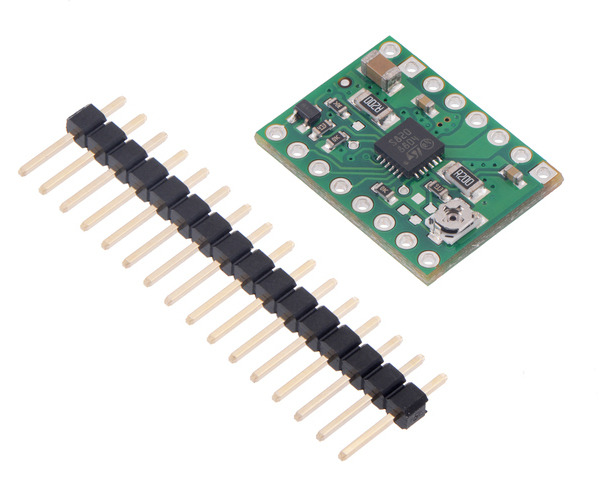

This is a merged information page for Item #2878.
View normal product page.
Pololu item #:
2878
Brand:
Pololu
Status:
Active

This breakout board for STMicro’s STSPIN820 microstepping bipolar stepper motor driver offers microstepping down to 1/256-step and a wide operating range of 7 V to 45 V. It can deliver up to approximately 0.9 A per phase continuously without a heat sink or forced air flow (up to 1.5 A peak). The module has a pinout and interface that are very similar to that of our popular A4988 carriers, so it can be used as a drop-in replacement for those boards in many applications.
Alternatives available with variations in these parameter(s): header pins soldered? Select variant…
 Compare all products in STSPIN820 Stepper Motor Driver Carriers or
Compare all products in STSPIN820 Stepper Motor Driver Carriers or  16-pin Stepper Motor Drivers.
16-pin Stepper Motor Drivers.
 |
STSPIN820 Stepper Motor Driver Carrier with included headers. |
|---|
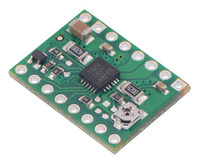 |
STSPIN820 Stepper Motor Driver Carrier. |
|---|
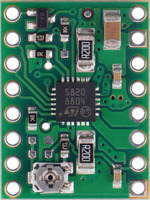 |
STSPIN820 Stepper Motor Driver Carrier (top view). |
|---|
 |
STSPIN820 Stepper Motor Driver Carrier, bottom view with dimensions. |
|---|
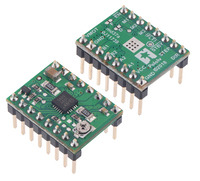 |
STSPIN820 Stepper Motor Driver Carriers with included header pins soldered. |
|---|
 |
Minimal wiring diagram for connecting a microcontroller to a STSPIN820 stepper motor driver carrier. |
|---|
 |
Jumpers for FLT and DECAY pins on the STSPIN820 stepper driver carrier. |
|---|
 |
Schematic diagram of the STSPIN820 Stepper Motor Driver Carrier. |
|---|
 |
STSPIN820 Stepper Motor Driver Carrier, bottom view with dimensions. |
|---|
This product is a carrier board or breakout board for the STSPIN820 stepper motor driver from STMicroelectronics (ST); we therefore recommend careful reading of the STSPIN820 datasheet (594k pdf) before using this product. This stepper motor driver offers microstep resolutions down to 1/256 of a step, and it lets you control one bipolar stepper motor at up to approximately 0.9 A per phase continuously without a heat sink or forced air flow (see the Power dissipation considerations section below for more information). Here are some of the driver’s key features:
This product ships with all surface-mount components—including the STSPIN820 driver IC—installed as shown in the product picture.
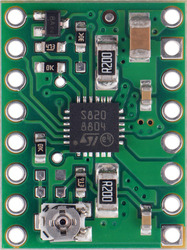 |
We also have a variety of other stepper motor driver options in this same form factor with different operating profiles and features.
The STSPIN820 stepper motor driver carrier ships with one 1×16-pin breakaway 0.1″ male headers (for a version of this carrier with header pins already installed, see item #2879). The headers can be soldered in for use with solderless breadboards or 0.1″ female connectors. You can also solder your motor leads and other connections directly to the board.
|
|
 |
Minimal wiring diagram for connecting a microcontroller to a STSPIN820 stepper motor driver carrier. |
|---|
The driver requires a logic supply voltage (3 – 5 V) to be connected across the VCC and GND pins and a motor supply voltage of 7 V to 45 V to be connected across VIN and GND. These supplies should have appropriate decoupling capacitors close to the board, and they should be capable of delivering the expected currents (peaks up to 3 A for the motor supply).
The STSPIN820 is intended to control a single bipolar stepper motor. The two sides of one coil should be connected across OUTA1 and OUTA2, and the two sides of the other coil should be connected across OUTB1 and OUTB2.
Warning: Connecting or disconnecting a stepper motor while the driver is powered can destroy the driver. (More generally, rewiring anything while it is powered is asking for trouble.)
Stepper motors typically have a step size specification (e.g. 1.8° or 200 steps per revolution), which applies to full steps. A microstepping driver such as the STSPIN820 allows higher resolutions by allowing intermediate step locations, which are achieved by energizing the coils with intermediate current levels. For instance, driving a motor in quarter-step mode will give the 200-step-per-revolution motor 800 microsteps per revolution by using four different current levels.
The resolution (step size) selector inputs (MODE1, MODE2, and MODE3) enable selection from the eight step resolutions according to the table below. These three pins are floating, so the MODE pins must be connected to logic high or low before operating the driver. For the microstep modes to function correctly, the current limit must be set low enough (see below) so that current limiting gets engaged. Otherwise, the intermediate current levels will not be correctly maintained, and the motor will skip microsteps.
| MODE1 | MODE2 | MODE3 | Microstep Resolution |
|---|---|---|---|
| Low | Low | Low | Full step |
| High | Low | Low | Half step |
| Low | High | Low | 1/4 step |
| High | High | Low | 1/8 step |
| Low | Low | High | 1/16 step |
| High | Low | High | 1/32 step |
| Low | High | High | 1/128 step |
| High | High | High | 1/256 step |
The rising edge of each pulse to the STEP (STCK) input corresponds to one microstep of the stepper motor in the direction selected by the DIR pin. Unlike most of our other stepper motor driver carriers, the STEP and DIR inputs are floating, so they must be connected to logic high or low to ensure proper operation.
The STSPIN820 IC has two different inputs for controlling its power states, STBY/RESET and EN/FAULT:
The STSPIN820 can detect several fault (error) states that it reports by driving EN/FAULT pin on the driver low. The FAULT pin is not made available by default (to avoid conflicts when using the STSPIN820 carrier as a drop-in replacement for our other stepper motor driver carriers), but it can be connected to the pin labeled “( FLT )” by bridging the surface mount jumper labeled “F” on the bottom side of the board.
On our carrier, the DECAY input is pulled down with a 10k resistor that sets the driver to mixed decay mode. The driver can be set to slow decay mode by bridging the surface mount jumper labeled “D” on the bottom side of the board.
 |
Jumpers for FLT and DECAY pins on the STSPIN820 stepper driver carrier. |
|---|
To achieve high step rates, the motor supply is typically higher than would be permissible without active current limiting. For instance, a typical stepper motor might have a maximum current rating of 1 A with a 5 Ω coil resistance, which would indicate a maximum motor supply of 5 V. Using such a motor with 10 V would allow higher step rates, but the current must actively be limited to under 1 A to prevent damage to the motor.
The STSPIN820 supports such active current limiting, and the trimmer potentiometer on the board can be used to set the current limit. You will typically want to set the driver’s current limit to be at or below the current rating of your stepper motor. One way to set the current limit is to put the driver into full-step mode and to measure the current running through a single motor coil without clocking the STEP input. The measured current will be equal to the current limit (since both coils are always on and limited to 100% of the current limit setting in full-step mode).
Another way to set the current limit is to measure the VREF voltage and calculate the resulting current limit. The VREF pin voltage is accessible via a small hole that is circled on the bottom silkscreen of the circuit board. The current limit in amps relates to the reference voltage in volts as follows:
``text(Current Limit) = text(VREF) * 5``
or, rearranged to solve for VREF:
``text(VREF) = text(Current Limit) / 5``
Note: The coil current can be very different from the power supply current, so you should not use the current measured at the power supply to set the current limit. The appropriate place to put your current meter is in series with one of your stepper motor coils. If the driver is in full-step mode, both coils will always be on and limited to 100% of the current limit setting as (unlike some other drivers that limit it to about 70% in full-step mode). If your driver is in one of the microstepping modes, the current through the coils will change with each step, ranging from 0% to 100% of the set limit.
The driver ICs have maximum current ratings higher than the continuous currents we specify for these carrier boards, but the actual current you can deliver depends on how well you can keep the IC cool. The carrier’s printed circuit board is designed to draw heat out of the IC, but to supply more than the specified continuous current per coil, a heat sink or other cooling method is required.
This product can get hot enough to burn you long before the chip overheats. Take care when handling this product and other components connected to it.
Please note that measuring the current draw at the power supply will generally not provide an accurate measure of the coil current. Since the input voltage to the driver can be significantly higher than the coil voltage, the measured current on the power supply can be quite a bit lower than the coil current (the driver and coil basically act like a switching step-down power supply). Also, if the supply voltage is very high compared to what the motor needs to achieve the set current, the duty cycle will be very low, which also leads to significant differences between average and RMS currents. Additionally, please note that the coil current is a function of the set current limit, but it does not necessarily equal the current limit setting as the actual current through each coil changes with each microstep and can be further reduced if Active Gain Control is active.
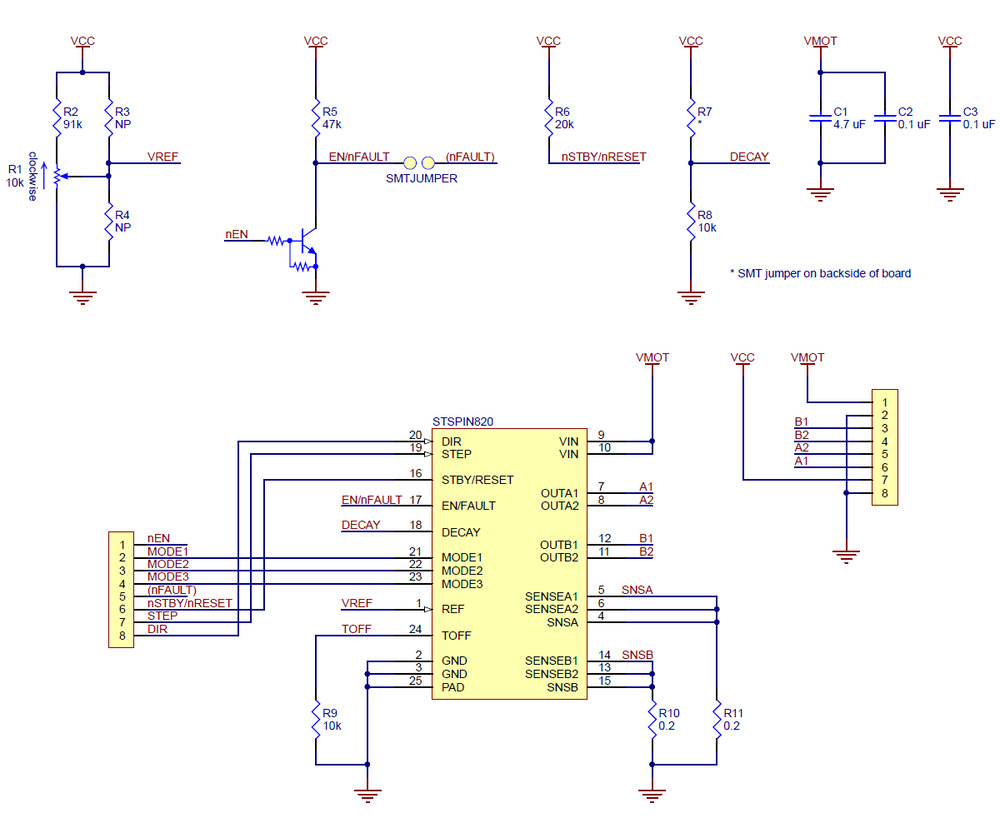 |
Schematic diagram of the STSPIN820 Stepper Motor Driver Carrier. |
|---|
This schematic is also available as a downloadable pdf (109k pdf).
| Size: | 0.6″ × 0.8″ |
|---|---|
| Weight: | 1.4 g1 |
| Motor driver: | STSPIN820 |
|---|---|
| Minimum operating voltage: | 7 V |
| Maximum operating voltage: | 45 V |
| Continuous current per phase: | 0.9 A |
| Maximum current per phase: | 1.5 A |
| Minimum logic voltage: | 2 V |
| Maximum logic voltage: | 5.5 V |
| Microstep resolutions: | full, 1/2, 1/4, 1/8, 1/16, 1/32, 1/128, 1/256 |
| Current limit control: | potentiometer |
| Reverse voltage protection?: | N |
| Header pins soldered?: | N |
| PCB dev codes: | md37a |
|---|---|
| Other PCB markings: | 0J11739 |
This DXF drawing shows the locations of all of the board’s holes.
ST’s product page for the STSPIN820 Advanced 256 microsteps integrated motor driver with step-clock and direction interface, with links to its most up-to-date datasheet and other resources.
Yes. To avoid damaging your stepper motor, you want to avoid exceeding the rated current, which is 600 mA in this instance. All of our stepper motor drivers let you limit the maximum current, so as long as you set the limit below the rated current, you will be within spec for your motor, even if the voltage exceeds the rated voltage. The voltage rating is just the voltage at which each coil draws the rated current, so the coils of your stepper motor will draw 600 mA at 3.9 V. By using a higher voltage along with active current limiting, the current is able to ramp up faster, which lets you achieve higher step rates than you could using the rated voltage.
If you do want to use a lower motor supply voltage for other reasons, consider using our DRV8834 or STSPIN-220 low-voltage stepper motor drivers.
Yes, you do! Setting the current limit on your stepper motor driver carrier before connecting your motor is essential to making sure that it runs properly. An appropriate current limit also ensures that your motor is not allowed to draw more current than it or your driver can handle, since that is likely to damage one or both of them.
Setting the current limit on our A4988, DRV8825, DRV8824, DRV8834, DRV8880, STSPINx20, and TB67SxFTG stepper motor driver carriers is done by adjusting the on-board potentiometer. We strongly recommend using a multimeter to measure the VREF voltage while setting the current limit so you can be sure you set it to an appropriate value (just turning the pot randomly until things seem to work is not a good approach). The following video has more details on setting the current limit:
We have yet another new stepper motor driver carrier in our popular 16-pin, 0.6″ × 0.8″ form factor, this time for STMicro’s STSPIN820, which...